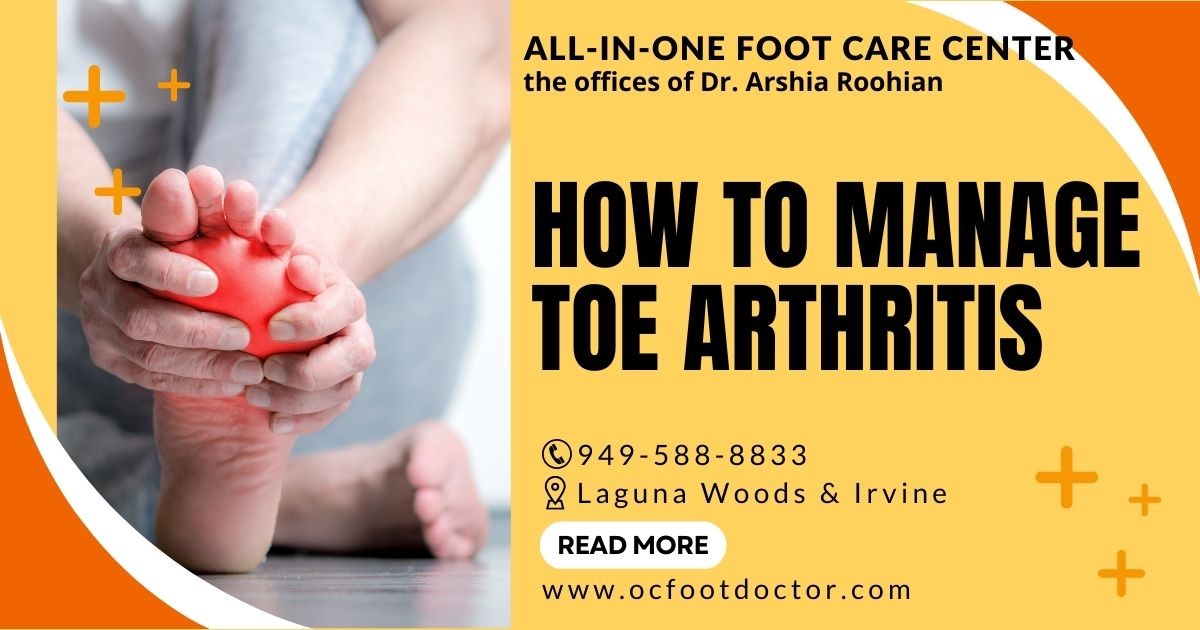How to Manage Toe Arthritis

There are several types of arthritis that can cause pain in your toes, including osteoarthritis, rheumatoid arthritis, and gout. Inflammation, swelling, and stiffness are all symptoms of arthritis. Inflamed, swollen, or painful toe joints make walking and even standing difficult.
All-In-One Foot Care Center specializes in ailments of the feet, ankles, and toes. We can help you manage your toe arthritis and live a more comfortable life with the right treatment and support for your toe. Here are four tips for managing your pain.
1. Medication available over-the-counter
.jpg)
In addition to aspirin, ibuprofen, and naproxen, nonsteroidal anti-inflammatory drugs are readily available. Celecoxib, diclofenac, and nabumetone are prescription NSAIDs. Pain associated with arthritis can be relieved by NSAIDs.
An NSAID prevents the production of prostaglandins by enzymes called cyclooxygenases. Pain and inflammation are caused by prostaglandins, which act like hormones.
In most cases, NSAIDs are taken orally in pill form, but topical versions may also be used. It may be helpful to apply creams directly to the skin covering the affected joint. You may be better off using a topical NSAID rather than an oral medication to treat your toe pain, depending on your medical history.
Long-term use of oral NSAIDs can cause serious side effects. There is a possibility that you could develop ulcers, high blood pressure, or kidney damage.
2. Toe exercises
.jpg)
Stretching your toes specifically can help you develop better flexibility, improve your range of motion, and reduce your pain. Exercise may slow the progression of arthritis depending on when you begin doing them.
We will show you the stretches that are best suited to your condition at All-In-One Foot Care Center. Exercise can also help you maintain proper alignment of your foot and ankle by strengthening the structures that support your toe joint.
3. Make sure you choose the right shoes
.jpg)
As well as causing pain, arthritis damages your joints as well. Bones grind against each other painfully when their cartilage degenerates, causing them to grind against each other. It is also possible for you to develop bone spurs at the base of your toes.
It is particularly important when you have toe arthritis to ensure your shoes fit properly. Shoes can become very uncomfortable when they don't fit properly. In order to protect your toe joint, you should choose shoes that provide cushioning, support, and a rigid sole.
It is possible for shoes with a narrow toe box to increase friction and cause calluses or bunions to develop. It is also problematic to wear heels because they add pressure to your tender toe and hold your foot at an unnatural angle.
Measuring your feet is one way to get the right fit. It is also important to look for specific characteristics, such as:
- Wide toe boxes
- The shape of the toe box is square or round
- Only the toes bend on a rigid sole
- Stable heel counters are those parts of the shoe that cup your heels
- If you need custom orthotics, you can remove the insoles
- Toes won't be rubbed by the shoe's top
- A heel that is no more than two inches high
4. Custom-molded orthotics are recommended
An orthotic is an insert that fits inside your shoe to relieve pain. Drug stores sell some types of orthotics, but we recommend custom-molded orthotics, which are designed specifically for your foot.
Our custom orthotics are made after we analyze your walking style. Your feet are then taken for impressions. A lab creates orthotics that address your specific issues and fit your unique fit based on the impressions you provide.
Having arthritis in your toe doesn't mean you're stuck with debilitating pain. We can help you manage this painful condition if you schedule an appointment today.
You can contact our office at 949-588-8833 , or visit our website at https://www.ocfootdoctor.com/ Our offices are located in Laguna Hills, Irvine, Mission Viejo, Aliso Viejo, Lake Forest, Foothill Ranch, and Costa Mesa.


